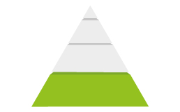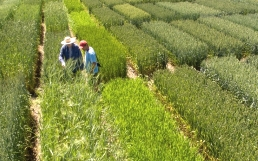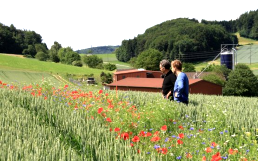Preventive measures

Crop protection begins with a considered choice of resistant species and varieties, which minimises plant-health risks. Crop systems (crop rotation, tillage, manuring, etc.) are also a mechanism for reducing the emergence and development of harmful organisms. Today, we know for certain that a species-rich, diversified agricultural ecosystem is more resilient and sustainable. But how do we encourage the beneficial organisms that contribute to the proper functioning of the soil and to crop development? Agroscope research covers these issues whilst also addressing the control of new diseases that could potentially be imported. “An ounce of prevention is worth a pound of cure” goes the old adage, which is also bang up-to-date when it comes to the health of plants and the environment.
Varietal selection promotes disease resistance

The selection of resistant varieties is the royal road for dealing with diseases and dispensing with curative treatments. Agroscope’s wheat selection programme, for example, allows farmers to forgo the use of fungicides and lodging inhibitors whilst guaranteeing a good yield and excellent breadmaking quality. Today, over 80% of the wheat sown in Switzerland comes from Agroscope varieties. Thanks to this, around 50% of Swiss wheat is produced without the use of synthetic chemical plant-protection products, reducing the use of these products by over 20 tonnes a year.
Agroscope began breeding cereals over 100 years ago, because even back then farmers were concerned with seed and variety quality. Breeding begins with the selection of ‘parent plants’ with outstanding and mutually complementary traits such as disease resistance, yield potential, climate adaptability and breadmaking quality. Preparation and pollination of the inflorescences is by hand, on just a few plants only. Marker-assisted selection (MAS) in the laboratory accelerates the breeding process, with molecular markers checking whether the desired genes are present in the offspring. Potentially worthwhile crossings then undergo several years’ testing in the greenhouse and field. Only the best wheat varieties will ultimately be included in the national catalogue of recommended varieties, usually 10 to 15 years after the first generation. Since cereal diseases are constantly evolving, variety breeding must carry on in order to provide farmers with new and resistant varieties.
Towards eco-compatible cultivation systems

Nowadays, it is taken as read that wheat or maize monocultures reduce biodiversity and create a fragile, disease-prone ecosystem. In Switzerland, agriculture is still relatively diversified; agricultural-policy measures play an important role, since this diversity entails higher costs and requires more know-how than a monoculture system. Crop rotation, a suitable choice of cultivated species, cover crops, and different forms of tillage make it possible to disrupt the life cycles of numerous pests and pathogens and to control weeds.
To give an example, the Western corn rootworm Diabrotica virgifera, a pest which arrived in Europe in the noughties, causes major damage in maize crops worldwide. The insect lives in maize crops and lays its eggs in the soil at the end of the summer; the larvae hatch and overwinter in the soil. In the spring, they feed on the roots of the maize plant – or simply die off if the plot has been sown with wheat. Agroscope has thus been able to demonstrate that the corn rootworm can be eliminated effectively without plant-protection treatment provided that the maize is followed by another crop, generally a cereal, the following year.
Biodiversity not only supports the equilibrium and conservation of natural ecosystems, but also supports agricultural crops and soil fertility. Promoting insects – especially pollinators – as well as bacteria and fungi thus makes sense on two counts. We know today that practices such as cover cropping, flower strips, companion cropping, the planting of hedges and the installation of small structures (piles of branches, stone walls, temporary ponds, etc.) help to increase biodiversity. Today, Agroscope research aims to understand what crops and systems in a given environment can promote biodiversity and reduce inputs whilst increasing yields. Growing oilseed rape with companion plants (wheat, peas, etc.), for example, brings major benefits in terms of weed management (no treatment necessary) and yield (less fertiliser thanks to legumes), whilst promoting biodiversity.
Preventing the importation of harmful organisms

Globalisation increases the risk of harmful organisms entering Switzerland by sea or by air. Because they have no natural enemies here, they can spread quickly. Border control and quarantine play a crucial role in combating imported pathogens. In this context, Agroscope works in particular to analyse and identify organisms that are harmful to plants. In collaboration with the Swiss Federal Plant Protection Service, for example, Agroscope has developed a rapid diagnosis system for identifying pathogenic organisms potentially found in imported plant material.





